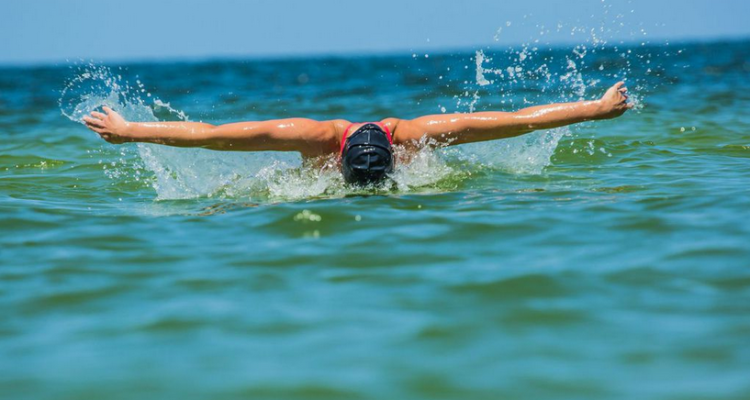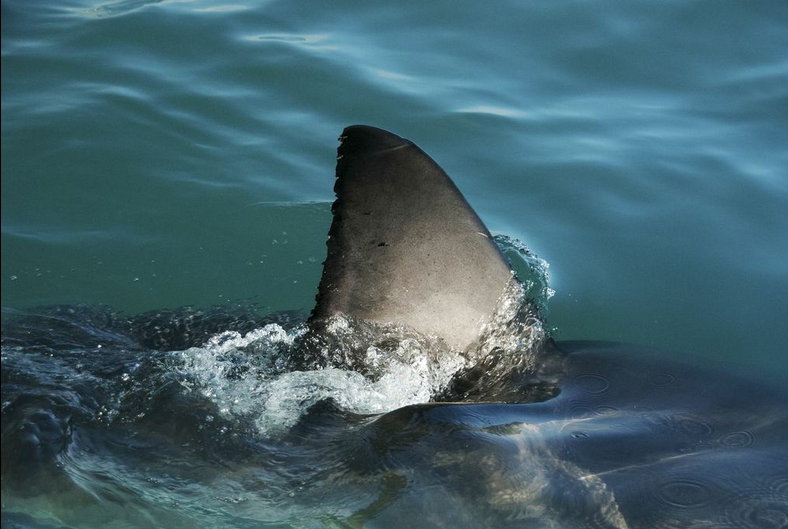Just when you thought it was safe to get in the water…
Two years ago, the Park-to-Pier swim was over almost as soon as it started. The day began innocently enough. Athletes lined the water’s edge as they made last minute goggle adjustments and the warm sun rose over the Gulf of Mexico. The air horn sounded and 200 or so toned bodies sprinted for the surf. What no one knew was that a jellyfish bloom had happened in the days leading up to the event. Moments after hitting the water, athletes came streaming back out—this time sporting a confetti-like smattering of brand new, bright red jellyfish stings.
“I always remember that I’m a guest in the ocean,” says Matt Reedy, founder and coach at Leapfrog Athletics. He leads group swims every Friday night during the summer, but he never forgets that we’re truly landlubbers.
And that’s wise advice. While our waterways are generally safe for swimming, what’s lurking within them may surprise you. Of course, this doesn’t mean you shouldn’t swim. Far from it. Open water swimming is terrific, impact-free exercise. Better yet, besides the nominal investment in a pair of goggles, a swim cap and a bathing suit, it’s completely free.
Jill Castle Moreland, who coaches the Gulf Coast Swim Team and has been training in open water regularly for the past five years, says that she feels completely safe in our local waters—both fresh and salt. “I’ve really never had an issue, if you see something in the water, most of the time it wants to get away from you more than you want to get away from it.”
But what is “it?” Well, we’ve got good news and bad news. It really could be a shark, but it could also be any number of other critters. Read on for everything you need to know about staying safe in the water this summer.
SHARK!
We would be lying if we told you that dark mass that swam past you probably isn’t a shark.
It’s entirely possible that it was a shark.
Indeed, there are seven types of shark that call Southwest Florida waters home. And a 2009 study found that sharks—especially great whites—hang out much closer to shore than researchers had originally thought. (Also, while great whites are rare here, a tagged great white named “Betsey” and one named Elizabeth were both tracked in the waters off of Boca Grande this May.)
Sounds terrifying, right? It shouldn’t be. Florida does have more shark attacks (and really, experts say the term “attack” is misleading, as most attacks are simply cases of mistaken identity) than any other state in the U.S. Still, since 2001 there have only been 295 total shark attacks in the state, only three of which were fatal. To put that in perspective, in 2009 alone there were 2,558 fatalities from motor vehicle accidents in Florida. You’re way more likely to die on the way to the beach than to die from a shark bite. Even more reassuring, according to the International Shark Attack File, Lee and Collier Counties have had only seven shark attacks a piece since 1882. None have been fatal.
If you do spot a shark, Katie Laakkonen, an environmental specialist for the City of Naples suggests swimming to shore as calmly as possible. Try not to panic or splash like an injured animal.
Other Tall, Dark and Mysterious Characters
During the late spring and late fall it’s possible the large creature swimming nearby is a cownose ray. Twice a year rays pass by our shores as they migrate to and from warmer Mexican waters. If you’re lucky, you could see a school of hundreds or even thousands go by. “Rays do have a barb, they can sting, but it’s uncommon,” says Laakkonen. “If you just leave them alone they’ll generally just swim on by you,” she adds.
Also occasionally found on or near beaches are American crocodiles and American alligators. “Every now and then an alligator will make it’s way onto the beach, they can handle saltwater,” says Laakkonen. And while she’s unaware of any established crocodile populations on this coast, sightings—especially near the Marco Island Airport—are not unheard of.
Both alligators and crocodiles pose little-to-no risk to humans. “There isn’t a lake in this state without a gator in it,” says Moreland, adding that a few gators never stopped her from swimming. She’s smart not to let them scare her: There hasn’t been a fatal gator attack in Florida since 2007, and almost all alligator attacks are the result of an alligator becoming accustomed to being fed by humans. Like sharks and rays, if you see a gator in the water, swim calmly towards land.
And what you saw could have also been a dolphin. Locally you’re most likely see bottlenose dolphins, which are generally known as being harmless to humans. Of course, that doesn’t mean they’re approachable. Touching and feeding dolphins is prohibited, so if you see one, just keep swimming.
Small but Mightily Annoying
Okay, so your chance of being crunched mid-stroke by something with dagger-like teeth is actually kind of slim. That should make you feel better. So now the bad news: There are things you legitimately need to worry about in the water—unfortunately, most of them you can’t see.
While the types of jellyfish we have locally aren’t likely to cause long-term damage with their stings, they’re still annoying. Laakkonen says that the best way to protect yourself is to know the conditions that often trigger blooms, like warm weather and lots of runoff from rain. The runoff provides food for the jellyfish—but also hurts local fish species that would have preyed on the jellies. The warm temperatures encourage them to breed. If the tides are right, we can get a bloom that lingers right offshore for days.
Similarly, you’ll often hear about people getting something called “sea lice.”
“It’s actually a misnomer,” says Laakkonen. “Sea lice affect fish, not humans.” Instead, what people are feeling are the stings from tiny larval stage jellyfish. “They’re hard to see in the water, but the larva can get into your swimsuit, get trapped and fire their toxin into your skin,” Laakkonen adds.
According to the University of Arkansas, which publishes an entire website devoted to medical myths, both urine and vinegar will not help soothe a jellyfish sting. Instead, wash the area with salt water (fresh water can makes things worse, as it can react with the neurotoxins that jellyfish release) and try to scrape off any remaining tentacles from the skin, using either a glove or a plastic credit card. Allergies to jellyfish stings do happen, so if someone appears to be having a violent response to a sting, seek medical help immediately.
While jellyfish are annoying, it may be the tiniest creatures of all that really do the most damage when swimming.
Last year Vibrio vulnificus, a “flesh-eating” bacteria, infected five people in Lee County—two died. The bacteria thrive in warm, salty water; so most U.S. cases come from the Gulf Coast states. Most often it is contracted by swimmers who enter the water with open wounds, so it’s important to never swim with any kind of skin laceration. The Lee County Department of Health says it sees about five cases a year, but that last year’s two fatalities were unusual.
Freshwater has its own dangers too, including the nasty Naegleria fowleri, akaPrimary Amebic Meningoencepalitis aka PAM aka brain-eating amoebas. According to state health records, of the 123 confirmed cases from 1962 to 2011 only one person has ever survived an encounter with PAM, so this is serious stuff. Essentially, Primary Amebic Meningoencepalitis enters the body through the nose; you can’t get it from swallowing infected water. It travels up your nose and into your brain, where it destroys your brain tissue. Horror movie stuff, right?
Symptoms start 11-14 days after infection, and include a fever, nausea, headache and a stiff neck. Usually within three to seven days of showing symptoms the patient dies. However, early intervention may be the ticket to saving patients—if you suspect you may have gotten infected water in your nose and you start to show symptoms, contact your doctor immediately. Doctor’s aren’t entirely clear on the best way to treat PAM, but they’ll likely give you several different drugs in hopes one will stave off the infection.
This all sounds bad, right? Here’s a bit of news to put your mind at ease: local waters really are very, very safe—and there’s data to prove it! Every other week a Collier County Department of Health employee stops by 10 different Collier County beaches to test for fecal coliform—or, well, poop bacteria. “It would be an indication of either a sewage leak or a gastrointestinal accident,” says Rachel Van Blaricom, the environmental health manager for Collier County. If a test came back positive, a second sample would be tested. If that too came back positive, notices would be posted on local beaches, but Van Blaricom says that the beaches would, in fact, remain open.
Luckily, a test hasn’t come back positive since 2007—so that’s surely something to cheer about. “The beach really is one of this area’s selling points, so I think it’s really been a group effort to keep them clean,” says Van Blaricom, adding, “there are just so many people looking out for our resources.”
So go ahead, jump right in; the water is (mostly) fine!


